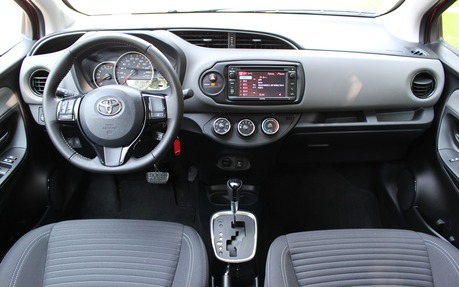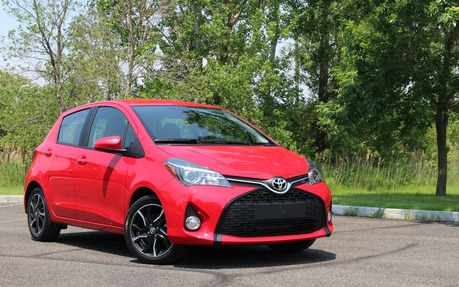2017 Toyota Yaris Hatchback: From A to B
When people shop for a can opener, a washing machine or a stapler, how many actually choose the most stylish, the most powerful or the most expensive model on the market? Very few, I assume. As long as they’re reliable, these items should provide years of worry-free ownership, whether they’re actually fun to use or not.
Could the same thinking be applied to a car? Of course, but members of the automotive press don’t seem to share that idea. Obviously, our job is to inform the consumer on how well a vehicle drives, from a performance standpoint, but also based on more rational aspects such as comfort and convenience, reliability and everyday practicality.
- Also: 2016 Toyota Yaris Sedan: The Adopted Child has Talent
- Also: 2018 Toyota C-HR: Toyota's Sexy Diamond
The 2017 Toyota Yaris Hatchback is a boring car to drive. There, we said it. Now, does that mean you shouldn’t buy one? Absolutely not.
In the subcompact-car segment, the models that provide the most smiles behind the wheel are the Ford Fiesta, the Chevrolet Sonic and the Toyota Yaris Sedan. The most versatile models are the Honda Fit for its clever folding rear seat and cargo capacity, and the Nissan Versa Note for its spacious back seat. The most value-packed models are the Hyundai Accent and the Kia Rio, which offer uplevel features at a low price. Where does that leave the Yaris Hatchback? It’s likely the most bulletproof, and the one who’ll hold its value the longest.
The Yaris Hatchback, in three-door and five-door body styles, relies on a relatively low-tech powertrain that consists of a 1.5-litre four-cylinder that produces 106 horsepower and 103 pound-feet of torque. That’s not much compared to the 130 horses of the Fit, the Accent and the Rio. However, unless we’re always in a hurry, it’s enough for the daily commute. The Toyota’s short turning radius is great for city life, although on the highway, the numb steering feel and suspension noise can get tiresome after a while.

A five-speed manual transmission is standard, but most consumers will spend an extra grand on the optional four-speed automatic. A four-gear transmission in 2017 is like having a portable telephone on which you can talk to or text someone, but can’t check Facebook or shoot video. It works, and that’s what’s important.
The problem is that a greater number of gears normally provides better fuel economy, because the engine would be spinning at lower revs on the highway, and the between delay each upshift or downshift wouldn’t be as long, and that also means less a less solicited engine. Still, the Yaris’ powertrain is proven technology and we ended up with an overall average of 7.0 L/100 km. Good, but not the best in its class.
The 2017 Toyota Yaris Hatchback’s drive is as exciting as eating unflavoured rice cakes. In contrast, the Mazda-sourced Yaris Sedan is more agile, with a sportier chassis and a more willing engine, even though both cars boast virtually the same output. For the record, the Yaris Sedan is built in Mexico, while the hatchback is assembled in France.
There’s also nothing exciting about the interior design of the Yaris Hatchback, although it’s not an eyesore either. The seat upholstery and leather-wrapped wheel with contrast stitching of our SE tester does spruce things up, while the heating and ventilation controls couldn’t be any simpler. The infotainment system with 6.1-inch touchscreen covers the basics and is standard in every trim level.
The front seats offer an adequate level of comfort and support for the daily commute, although a centre armrest would be a welcome addition. In back, the flat floor provides more foot space for three occupants, although two adults will obviously be more at ease then three. Cargo space is rated at 442 litres with the rear seatbacks in place, which is a little optimistic. Toyota Canada doesn’t publish a max volume rating with the seats folded down, but the European figure for the Yaris is 1119 litres.

Every Yaris with a hatchback includes the company’s Toyota Safety Sense (TSS-C) suite of advanced driving aids, such as forward collision warning, lane departure alert and automatic high beams.
The 2017 Toyota Yaris Hatchback starts out at $15,475 before freight and delivery charges, and that’s for the three-door variant. Our five-door SE with the automatic transmission is priced at $19,510, which isn’t a bargain in the subcompact segment. However, the Yaris holds its value for quite a while, so it’s basically money in the bank.
Note that the 2018 Toyota Yaris Hatchback will be on sale imminently, which benefits from yet another round of cosmetic updates, but also a standard rearview camera and heated front seats across the board. It also receives a price drop of about $100 to $150. With more features included and pricing on hold, the Yaris becomes more competitive. Unless we can get a really good deal on the new 2017, we probably should wait for the 2018 model.
For the rest, the Yaris Hatchback remains a popular choice in its category because it has a reputation for being reliable. For getting from point A to B uneventfully, consumers can’t really go wrong with the little Toyota. However, those who want a little more out of their car should check out some of its competitors before signing the contract.
| Test drive report | |
| Test model | 2017 Toyota Yaris |
|---|---|
| Trim level | SE 5 Door Hatchback |
| Price range | $15,475 – $19,510 |
| Price as tested | CA$19,510 |
| Warranty (basic) | 3 years/60,000 km |
| Warranty (powertrain) | 5 years/100,000 km |
| Fuel economy (city/highway/observed) | 7.7 / 6.3 / 7.0 L/100km |
| Options | Four-speed automatic transmission ($1,000) |
| Competitive models | Chevrolet Sonic, Ford Fiesta, Honda Fit, Hyundai Accent, Kia Rio, Nissan Versa Note |
| Strong points |
|
| Weak points |
|
| Editor's rating | |
| Fuel economy | Not bad, but could be better if Toyota would equip the car with a six-speed automatic |
| Comfort | Decent ride and decent seats, but we long for a centre armrest up front |
| Performance | The 1.5-litre engine does the job, yet isn’t an overachiever |
| Infotainment | A good-sized touchscreen and a basic set of features, but doesn’t feel very sophisticated |
| Driving | Clearly, the Yaris Hatchback wasn’t designed to provide an exhilarating driving experience |
| Overall | The Yaris Hatchback is better than the sum of its parts, because its parts hold together for a long time |
